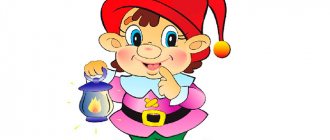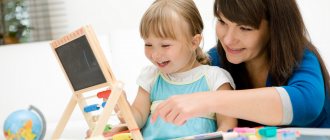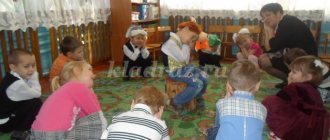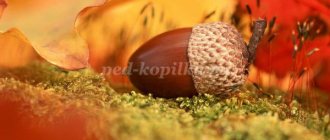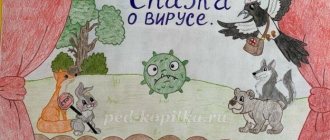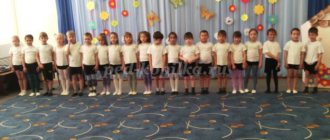Junior group. Early childhood, nursery. Children 1-4 years old
Summary of entertainment for young children “Visiting the cat Vaska” Hello, guys, I’m very glad to see you in the music room. Tell me, would you like to go on a visit today? I suggest you go visit the cat Vaska. Well, it's time to go to the cat's house, let's go along the path. We walk along the path. We walked along the path to the house...
Winter entertainment “Winter walk” with outdoor games in the early age group “Winter walk” Purpose: To develop children’s interest in physical education and to introduce them to a healthy lifestyle. Objectives: 1. To teach children to walk and run with free, natural movements of their hands, to teach figurative performance of various movements. 2. Develop in children...
Summary of physical education and mathematics leisure in the second junior group “Mathematical adventures”
Goal: Development of children's mathematical abilities through physical development.
Tasks:
Educational: Expand the ability to find one or many objects in a specially created environment. Continue learning to distinguish between a circle and a square. Compare circles by size: large, small.
Developmental: Develop activity, curiosity, speed, dexterity, attention.
Educational: Cultivate friendships and partnerships in children. Foster independence, interest and emotional responsiveness.
Attributes: Driver's hat, circle, square, cubes, balls, hoops, flat Snowman, magnetic board, pyramid, two boards wide and narrow.
Equipment: Laptop, musical accompaniment.
Leisure activities:
Children enter the gym. They are under construction. Warm-up is in progress.
Educator: Today we will go on an exciting journey. Let's go by train. I will be your driver. Get ready and let's go! Chug-chug! (music turns on). The children are traveling by train.
Look, the first stop is “Kvadratnaya”. Now we will build a large and a small house from cubes. You will need to build cube by cube. Our cube is square in shape. Show! A square has four corners. What kind of cubes do we have?
Big and small. Children are called. The teacher suggests building a large house, then the children build a small house. We compare who got a big house and who got a small one. Well done!
Let's move on. The music turns on. Children are traveling by train. The next stop is “Round”. Children look at the circle. The teacher invites the children to assemble a flat Snowman on a magnetic board. Find out what shape the circle is. Show! Tell that the large circle is attached first, then the medium one, and finally the small one. Children are called. We add a bucket, carrots, arms, and legs to the Snowman. Well done!
Task: “Assemble a pyramid.”
We specify the pyramid shape and color. The child is called. Well done!
Our train continues to move. The music turns on. Next stop “Sportivnaya”.
Assignment: “Collect balls and cubes in your baskets.”
At a signal, children collect balls in one basket and cubes in another. We check how the children completed the task. Well done!
Educator: Guys, let's move on. The music turns on. The next stop is “Wide - Narrow”.
First, the children walk one after another along a wide path, then along a narrow one.
And now we will play an outdoor game. The game “Birds in Nests” is played.
Children run in all directions without bumping into each other. At the signal “The birds have flown,” children fly out of their nests and fly. At the signal “Birds, go to their nests!” the children return to their places. For nests, hoops placed on the floor are used.
Summing up.
Guys, what did we travel on today?
By train!
We went on a trip to the stops “Kvadratnaya”, “Round”, “Sportivnaya”. We completed tasks and played an outdoor game. You are so great today! And now we will take a photo for memory.
Summary of physical education in the younger group
Summary of physical education leisure “Visiting the squirrel” in the junior group
Author: Ermilova Irina Aleksandrovna, teacher of the junior group, MDOU kindergarten No. 5 “Zvezdochka”, Atkarsk Description: This development will be of interest to teachers of the junior group Program content: Educational objectives:
1 Motivate children to engage in physical activity;
2. Strengthen various types of walking, running, jumping on two legs with forward movement; 3. Develop the ability to act in an organized manner, in accordance with the teacher’s command. 4.Formulate the simplest figurative and expressive skills in children (be able to imitate the characteristic movements of fairy-tale animals); 5. Contribute to the formation of correct posture; 6. Consolidate acquired knowledge about wild animals. Educational objectives:
1. Foster a desire to help others;
2. To foster in children an emotionally positive attitude towards physical exercise; Developmental tasks:
1.Develop physical qualities: strength, agility, spatial orientation, coordination of movements, speed, balance;
2.Develop thinking, memory, attention and speech of children; Children enter the gym. Bunny stands in the center of the hall and preens himself. Educator: Hello, Bunny! How smart you are. Otherwise, are you going to visit? Bunny: - Yes, I’m going to visit Squirrel. She invites you too. So get ready, it's time to go. Educator: - We will happily go to Squirrel, see how she lives in the forest, play with her. Just accompany us, please, Bunny. We don't know the way at all. Bunny: - Of course, follow me. (Children line up behind Bunny) Teacher: - Are you ready? Children: - Yes! Educator: - Well, then let's go! “We walk one after another through the forest and spring meadow. Breathe deeply through your nose, keep your back straight! (walking) We walk along the path, put our hands behind our backs and walk on our heels. (walking on heels) We came level with the back of our heads, and rose up on our tiptoes (walking on toes). We ran lightly (easy run). How the horses galloped (straight gallop). Hush, hush, don’t rush, go for a walk. Once again our legs are walking along the path” (walking). (The children stop in a circle. The bunny pays attention to the clearing with flowers.) Bunny: Now along this path we will find a clearing with flowers in the forest. (They approach a clearing where there is a basket of flowers.) Educator: - Guys, look, here is a clearing. Only someone has already collected the flowers in a basket. What beautiful flowers! What color are they? (individual and group response). Bunny: These flowers can be given to Squirrel. Educator: Okay, we’ll give x to Squirrel. But first, let's play with flowers and show Bunny how we can do exercises (Children stand in a circle, 2 flowers are handed out) Children: We are cheerful guys, Like athletic bunnies, We will jump and gallop We will develop our legs Exercises with flowers Educator: “Here flowers in front of us, Let's play with the flowers" 1) I.p. – legs slightly apart. Hands to chest. Lift the flowers up and look at them. Return to I.p. (4 times). Educator: “We are growing, growing, We are blooming, blooming” 2) I.p. - feet shoulder-width apart, arms down. Turns: one way, then - i.p. To another, i.p. (4 times in each direction). Educator: “Wave a flower there, Wave a flower here. Do it once, and do it twice!” 3) I.p. - hands near the chest. Bend forward, arms down, return to IP. (4 times). Educator: “Bend over, quickly stand up! Lean In, Smile!” 4) I.p. - hands near the chest. Squats (4 times). Educator: “We squat carefully and don’t drop the flowers!” 5) “Now let’s go, let’s go, And we won’t get tired.” (walking in place) 6) Breathing exercises Teacher: “And now we will blow on the flowers and warm the petals.” Take a deep breath and blow on them (5 times) Educator: How are you, guys? Children: Health is fine - Thanks to exercise! Bunny: You turned out to be strong and dexterous, I saw how hard you tried. (The teacher and the bunny collect flowers in a basket.) Teacher: Now we have become stronger and will definitely reach Squirrel. Really Bunny? Bunny: Yes. Educator: We get up one after another and hit the road. Various animals and birds live in the forest. Guess the riddle: A cunning cheat, A red head, A fluffy tail - a beauty, And her name is ..... (fox) (Fox comes out) Educator: Hello Fox. Lisa: Hello guys. I am a red fox, the whole forest is beautiful. There is no red fur coat in the forest, There is no more cunning beast in the forest. Where are you going? Educator: We are going to visit Squirrel. We bring her a basket of flowers. Show us the way to Squirrel. Fox: Play with me like little foxes first. Educator: Let's play like little foxes? ”(yes) Educator: Stand in a circle and walk one after another on your toes, like little foxes. “Here come our guys - real little foxes. They wag their tails and cover their tracks. They walk deftly on their tiptoes, like cheating foxes.” Educator: Well done, guys - good foxes. Now Fox, how can we get to Squirrel? Fox: To get to the squirrel, you need to cross the bridge. Educator: And here is the bridge. 1) We walk along the bridge carefully. (walking on the bridge) 2) The kids can’t get through here, they’ll have to crawl here. (crawling under an arc) 3) Boldly jump over the hillock, my friend. (jumping over soft modules) 4) Now let’s quickly pass like a snake, Maybe we’ll find a berry. (walking like a snake) (They approach the stump where the Hedgehog sits.) Educator: Meet this hedgehog, He is an expert on forest paths. Covered in needles - be careful, it can hurt to get pricked. Hello Hedgehog. Hedgehog: Hello, guys. I am prickly, like a Christmas tree, covered in needles from head to toe. I will find a fungus in the forest and bring it to the house on the back. Bunny: Hedgehog, why are you so sad? Hedgehog: I'm tired, I've lost all my cones. Educator: Hedgehog, the guys and I will help you collect them. Game “Collect cones” Educator: Well done, guys. We collected all the cones. Hedgehog, come with us to visit the squirrel. Together we walk merrily, gaining strength and agility. (They approach the Bear.) Educator: Guess the riddle, guys. He is a strict owner of the forest, He likes to sleep in a den in winter. He can roar loudly, Who is he? (Bear) That's right. Only he is sleeping. Let's wake him up. Stand around the bear. Outdoor game “Bear” Once we were walking in the forest and met a bear. He lies under the tree, (round dance step) Stretched out and snoring. We walked around him, waking up Clubfoot, “Come on, little darling, get up (they stop, shake their finger). And play with us!” (The bear gets up, stretches, plays with the children) The clumsy bear walks through the forest, collects cones and puts them in his pocket. A cone fell right on the bear's forehead. The bear got angry and stomped his foot! Educator: Bear, you and I played so well. And the guys know a poem about you. Teddy bear, little bear, couch potato, You slept long and deeply. I slept through the whole winter and didn’t make it to the Christmas tree. And I didn’t ride a sled, And I didn’t throw snowballs. If only the little target could snore, Oh, you little bear! Educator: Bear, come with us to Squirrel. (They go to Squirrel’s house. She has nuts in a plate on her table.) Guys, who do you think lives here and gnaws nuts? (Squirrel). (Belka comes out.) Belka: I walk around in a fluffy fur coat, I live in a dense forest. In a hollow on an old oak tree I gnaw nuts. Educator: Hello, Belka. Belka: Hello, guys. Educator: We came to visit you. Guys, what did we bring for Squirrel? (flowers) (They give flowers). We walked for so long, we were tired. Let's relax and listen to the birds singing in the forest. (A recording of birds singing in the forest sounds) Relaxation The dream has found its way, He has come to visit you, Don’t drive him away. Better sit down and rest. Breathe quietly through your nose, your eyelashes droop, your eyes close. We are resting peacefully. We fall asleep in a magical sleep. Breathe easily, evenly, deeply. Our hands are resting, Our legs are also resting, The neck is not tense, but relaxed, Breathe easily... evenly... deeply... We woke up, stretched, stretched, smiled. Now let's get up quietly. Educator: Guys, did you like our trip through the forest? (yes) What animals did we meet in the forest? (Hare, hedgehog, bear, fox, squirrel) How can they be called in one word? (wild animals) Who did you like best? And now it’s time for us to return to kindergarten. Belka: Guys, I want to treat you to some nuts. (Gives nuts) Educator: Thank you, Squirrel. Goodbye. Our feet walk along the level path. The children leave the hall.
We recommend watching:
Leisure time with parents. Junior-middle group Physical education “Journey to Lesovichok” Autumn physical education. Scenario for the younger group Scenario of physical education autumn leisure for children of the middle group “Visiting the squirrel”
Similar articles:
Physical education leisure in the 2nd junior group in the spring
Gaming leisure time in 1st junior group
Lesson notes for the early childhood group in kindergarten
Bird watching in the kindergarten area. Junior group
Summary of a game lesson for children of the third year of life on the topic: Leo
Leisure summary “Let's help the birds in winter” in the younger group
Leisure summary
“Let's help the birds in winter” in the younger group.
Integration of educational areas:
“Cognition of FEMP”, “Communication”, “Socialization”.
Goals:
• expand children's knowledge about the life of birds in winter, their habits, and nutrition;
• give children an idea of the types of food of wintering birds; • develop visual perception, coordination of movements; • develop observation skills, ability to compare, establish cause-and-effect relationships; intelligence in the process of solving riddles; • develop children's cognitive interest in the life of birds; • cultivate empathy, sympathy, and the desire to help birds in difficult winter conditions. Materials for the lesson:
audio recording “Voices of wintering birds”;
laptop; feeder; pictures depicting a sparrow, bullfinch, tit, crossbill; four saucers with rowan berries, seeds, a cone, a piece of lard; didactic game “Feed the bird”. Preliminary work:
• observing birds during walks;
• examination of didactic pictures “Wintering Birds”; • didactic game – puzzles “Birds in Winter”. Progress of the lesson 1. Organizational moment.
Educator –
Look how strong the wind is outside! A snowstorm swirled and spun us around. Look where we ended up - in the winter forest. How beautiful it is all around! But why is it so quiet? (Many birds flew away.)
Educator –
Yes, many birds have flown away, but not all. But in our forest, I cannot see a single bird. The birds hid from us, but if we listen carefully, we can hear their voices. Let's repeat with the birds what they sing:
-Chik-chirik (Sparrow).
-Tsok-tsek, tsok-tsek. (Crossbill).
-Rum-rum-rum. (Bullfinch).
-Ting-ting-ting. (Tit).
Educator–
So what birds stayed with us for the winter? (Bullfinch, tit, crossbill, sparrow). We can call them wintering.
Educator –
Guys, what benefits do birds bring?
(They bring joy, destroy harmful insects, and sing beautifully). Educator
- Wintering birds fly to our city from the forest for help. How can we help the birds?
I'll try to give you a hint - look what I brought? Educator
- That's right - it's a feeding trough.
And what is it for? (feed the birds in winter) Educator
- Guys, but since so many birds stayed with us for the winter, why did they fly past and not land on my feeder? (there is no food in the feeder).
Educator
-Oh, but I can’t remember something, what do birds eat in winter?
Guys, let's try to get to know the birds better together. 3. Work on describing and comparing birds. Educator
- Guys, look carefully at the birds and tell me how they are all similar?
(all birds have a body, head, legs, beak, wings, tail, and the body is covered with feathers). Educator
- Why do birds need wings?
(fly) Teacher
- Why do birds need paws?
(move on the ground, cling to branches) Educator
- Why do birds need a beak?
(eat, drink) - demonstration Teacher
- Guys, how do these birds differ from each other?
Educator
- That's right, they have different colors: the bullfinch has a red breast, and the tit has a yellow breast.
And the birds have different habits: sparrows like to sit on bushes, crossbills on spruce branches, bullfinches on rowan branches. Educator
- Guys, you are so great!
How much you told me about birds. Let's relax and jump like cheerful and nimble titmice. 4. Physical education.
A nimble tit is jumping, (jumping in place on two legs) She can’t sit still, (jumping in place on the left leg) Jump-jump, jump-jump, (jumping in place on the right leg) Spun like a top.
(spinning in place) So she sat down for a minute, (sat down) Scratched her chest with her beak, (stood up, tilted her head left and right) And from the path - onto the fence, Tiri-tiri, Shadow-shadow-shadow! (jumping in place on two legs) 5. Conversation “Who eats what?” Teacher
- Titmouse - the guys jumped, warmed up and the birds wanted to eat.
But we still haven’t figured out what different birds like to eat. In summer and autumn, tits and sparrows fed on beetles, grasshoppers, and caterpillars. But now, in winter, beetles and grasshoppers sleep under two blankets - autumn and winter, and cannot be reached. In winter, birds are cold and hungry. It is difficult for birds to find food under the snow. And you and I can help them by opening a poultry canteen. Let's create a menu for the bird's canteen. Educator
- Guys, tell me, what do birds eat?
(bread, crumbs, seeds). Educator
- That's right, guys. Look, I have some more treats on the table for wintering birds.
Let's find out which bird is pecking what. Melon and pumpkin seeds are pecked by crossbill, bullfinch, and sparrow. Tits love sunflower seeds and lard. Sparrows and tits peck at the oats. Millet and millet are the favorite food of sparrows. Rowan and viburnum berries are the favorite food of bullfinches. Continuation of the conversation “Who eats what?” Repetition: Educator
- Sparrows feed on grains, crumbs, and seeds.
Educator
- Tits feed on grains, crumbs, seeds, their favorite delicacy is lard.
Educator
- Bullfinches eat seeds and love to peck rowan berries.
Frozen berries respond well to a powerful bite. Shows a saucer with rowan berries. 7. Game “Feed the bird.” Educator
- Look carefully, we have saucers on the table: with rowan berries, bread crumbs, seeds.
Educator
- I will show you pictures of birds, and you must name the bird and find food for it.
8. Finger gymnastics “Wintering birds” Educator
- Now let’s practice feeding the birds.
Come, birds! (“calling” movements of the fingers) I will give lard to the titmouse (4 times – “cutting” movements of one palm on the other) I will prepare the crumbs (fingers with a pinch – “crumbing the bread”) A little bread. These crumbs are for the pigeons (extend your right hand forward with an open palm) These crumbs are for the sparrows (the same with your left hand) Jackdaws and crows Eat pasta! (rub palm against palm, “rolling pasta from bread”). 9. Summary of the lesson.
